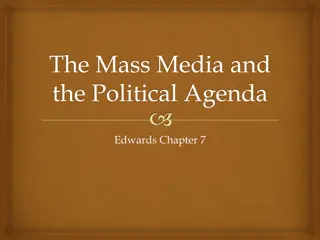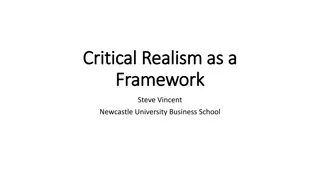Understanding Structural Realism in Global Politics
Structural realism in global politics focuses on the concept that states pursue power as a means of survival in an anarchic international system. Key differences between classical and structural realists lie in the perception of power as an end versus a means to an end. This perspective is based on the principles of anarchy, offensive military capability, uncertainty in state intentions, the primacy of state survival, and rational state behavior.
Download Presentation

Please find below an Image/Link to download the presentation.
The content on the website is provided AS IS for your information and personal use only. It may not be sold, licensed, or shared on other websites without obtaining consent from the author. Download presentation by click this link. If you encounter any issues during the download, it is possible that the publisher has removed the file from their server.
E N D
Presentation Transcript
Theoretical Perspectives: Realism IB Global Politics UWC Costa Rica
Realism in Global Politics Realism is a theoretical perspective in which power is seen as the currency of global politics States are concerned with how much power they have and how much power they have relative to other states Global Politics IS Power Politics
Structural Realist Theory WHY DO STATES WANT POWER? Classical Realist Theory
Classical Realism Human nature to want power States are led with by individuals with an innate need to dominate their rivals Hans Morgenthau
Structural Realism States pursue power because of the nature of the international system States are trapped in an iron cage where they have little option but to compete with each other for power to ensure their own survival John Mearsheimer
What is the key difference between classical and structural realists? Classical: Power is an end sui generis Structural: Power is a means to an end. The end is the survival of the state itself
We will focus on structural realism today A state s power comes from 2 sources: The material capabilities a state controls: military resources such as armoured divisions and nuclear weapons Latent power: based on a state s wealth and size of it s overall population
5 Key Assumptions of Structural Realism 1. States operate in an anarchic global system 2. All states possess some offensive military capability 3. States can never know the intentions of other states 4. The main goal of states is survival 5. States are rational actors
1. States operate in an anarchic system Anarchy is an ordering principle The is no central authority that stands above states in the system The opposite of anarchy is hierarchy which is the ordering principle of domestic politics
2. All states possess some offensive military capacity Each state has the power to inflict harm upon its neighbours Capacity varies massively between states
3. States can never know the intentions of other states States ultimately want to know whether other states are determined to use force to alter the balance of power (revisionist revisionist states), or whether they are satisfied enough with it that they have no interest in using force to change it (status quo status quo states). It is almost impossible to discern another state s intentions with a high degree of certainty. Unlike military capabilities, intentions cannot be empirically verified. Intentions are in the minds of decision-makers
4. The primary goal of all states is survival States also have other goals - e.g. prosperity, protecting human rights Survival is primary goal if a state does not survive it will not achieve any any of its goals
5. States are rational actors States are capable of coming up with sound strategies that maximize their prospects for survival. They may miscalculate from time to time. Because states operate with imperfect information in a complicated world, they sometimes make serious mistakes.
It gets more confusing Offensive Structural Realism It makes sense for states to pursue as much as power as possible Defensive Structural Realism Unwise for states to maximise their share of power as the global political system will punish them if they attempt to gain too much States should pursue hegemony where possible Pursuit of hegemony is foolish Key writer: John Mearsheimer Key writer: Kenneth Waltz
What is the key difference between offensive and defensive structural realists? HOW MUCH POWER IS ENOUGH?
Hegemony Offensive Realism Offensive realists argue that states should always be looking for opportunities to gain more power and should do so whenever it seems feasible. States should maximize power, and their ultimate goal should be hegemony, because that is the best way to guarantee survival
Hegemony Defensive Realism While defensive realists recognize that the international system creates strong incentives to gain additional increments of power, they maintain that it is strategically foolish to pursue hegemony hegemony. States should not maximize power, but should instead strive for what Kenneth Waltz calls an appropriate amount of power
Why show restraint? Reason 1 Defensive realists emphasize that if any state becomes too powerful, balancing will occur. E.g. Napoleonic France (1792 1815), Imperial Germany (1900 18), and Nazi Germany (1933 45) Otto von Bismarck s genius, according to the defensive realists, was that he understood that too much power was bad for Germany, because it would cause its neighbours to balance against it. So, he halted German expansion after winning stunning victories in the Austro-Prussian (1866) and Franco- Prussian (1870 1) Wars.
Why show restraint? Reason 2 There is an offence defence balance, which indicates how easy or difficult it is to conquer territory or defeat a defender in battle. The the offence defence balance is usually heavily weighted in the defender s favour. Any state that attempts to gain large amounts of additional power is likely to end up fighting a series of losing wars. Accordingly, states will recognize the futility of offence and concentrate instead on maintaining their position in the balance of power. If they do go on the offensive, their aims will be limited.
Why show restraint? Reason 3 Even when conquest is feasible, it does not pay: the costs outweigh the benefits. Because of nationalism, it is especially difficult, sometimes impossible, for the conqueror to subdue the conquered. The ideology of nationalism is all about self- determination, which virtually guarantees that occupied populations will rise up against the occupier
Conquest is not only difficult but, when it is successful, leads to many difficulties and few benefits
How do Offensive Realists respond? Claim balancing is often inefficient, especially when it comes to forming balancing coalitions, and that this inefficiency provides opportunities for a clever aggressor to take advantage of its adversaries. take issue with the claim that the defender has a significant advantage over the attacker, and thus offence hardly ever pays. acknowledge that sometimes conquest does not pay but they also point out that sometimes it does.
Anything in common? Both defensive and offensive realists agree, however, that nuclear weapons have little utility for offensive purposes, except where only one side in a conflict has them. The reason is simple: if both sides have a survivable retaliatory capability, neither gains an advantage from striking first. Moreover, both camps agree that conventional war between nuclear-armed states is possible but not likely, because of the danger of escalation to the nuclear level.
Case Study: Realism and the Rise of China We are going to try and apply what we have learnt by comparing how defensive and offensive realists might view the recent rise of China as a world power
Instructions Pt. 1 You have will be placed into one of four groups. Two groups will consider the case study from the offensive realist perspective and two from the defensive realist perspective You have 30 minutes to read through the article in your groups before creating a list of what you feel are the most important points. Each member of the group must have a copy of this list you may wish to create a shared google doc.
Instructions Pt. 2 You will now go back to your home group Two of you will be experts on the offensive realist view and two of you will be experts on the defensive realist view Together, you will create an essay plan, that answers the question Which perspective provides the most convincing answer to the question Can China rise peacefully ? You will have 40 minutes to create your essay plan and must be prepared to share your thoughts with the rest of the class.























